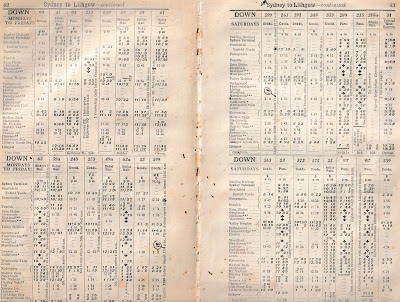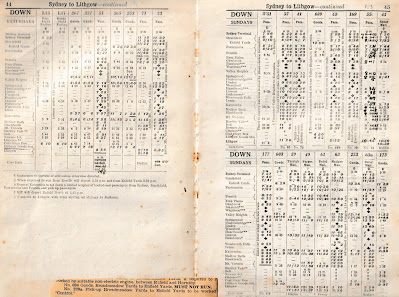There are many fabulous primary and secondary historical resources available for people interested in NSW railways. Working Time-Tables (WTTs), issued by the Railways to their staff, usually give a unique insight into operations as the Railways staff were obliged to update the information within their the pages in order to have a contemporary view of the rules applying to their jobs.
I am extremely fortunate to have a copy of the West WTT issued initially on 16 April 1962. While its cover suggests a nondescript publication, I have found valuable information about railway operations on virtually every page.
There is no indication who owned this copy of the WTT or what their role was. I can only surmise that they were likely a signalman based between Lithgow and Dubbo as the greatest attention has been paid to maintaining the currency of the information in that part of the publication. Here is just one example showing the person's labours.
Anyway, it is a sunny Sunday afternoon and I find the best way to pass these sorts of days is to snooze through some railway timetables. If you would like to read along, or download these photos for your later perusal, here are the pages applying to train workings between Sydney and Lithgow, including light engine workings at the rear. I just love how the paybus workings have close attention!
I will also put these pages up on my Flickr site - Don5617. In due course I will post other examples of workings across the NSW Railways Western Division.
Cheers,
Don












Hi Don
ReplyDeleteI have a 1965 Western TT, its old and lost original cover owing to it being torn, also as an ex driver in the 70's and fireman in the 60's getting the TT's in the 60's period was hard as to who was able to obtain copies.
In general those TT's were issued to Station Masters, drivers as the main recipients. Most Signal boxes did not receive copies though and most guards, however there was a habit where, except the large ones such as Werris Creek, Bathurst, Cootamundra and similar sized locations, others however were sourced by different means.
Drivers were issued with them based on the lines they worked over, usually they had to be signed for, and sometimes when a new one was published the old one had to be handed back, in many cases that did not happen, and became collectors items.
Drivers in depots that ran to more than one location/line received copies for those lines. eg Enfield - Eveleigh who worked to the West, North, South and Illawarra areas would get copies of those TT's and would take them when running over the lines with the TT that was needed for the shift. A metropolitan TT was issued to those depots as well.
TT's were not always found in signal boxes, as those that were open every day, they received a train amba, or program by phone hook up with signal boxes twice daily of trains running in the morning and late afternoon where the amba book had up & down program that were running. The amba's were given out by the train control officer and each signal box had to acknowledge they were on line with the phones, once all were called out, the control officer then called out the train numbers both down and up services.
Steam days would have a D associated with the train number, meaning double header. If a train was cancelled a C was wrapped around the train number cancelled.
Many of the train numbers gave what was a type of train priority, based on 2 or3 numbers, also the actual number would also define its priority in train running. Stock trains usually had a number 104 or similar as such a fast stock, even in diesel days.